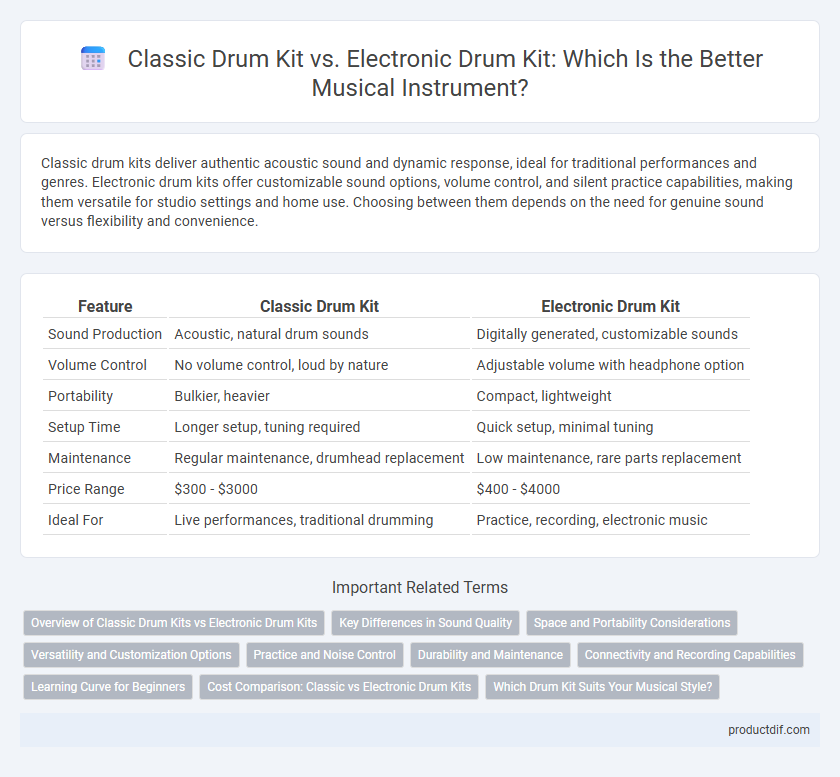Classic drum kits deliver authentic acoustic sound and dynamic response, ideal for traditional performances and genres. Electronic drum kits offer customizable sound options, volume control, and silent practice capabilities, making them versatile for studio settings and home use. Choosing between them depends on the need for genuine sound versus flexibility and convenience.
Table of Comparison
| Feature | Classic Drum Kit | Electronic Drum Kit |
|---|---|---|
| Sound Production | Acoustic, natural drum sounds | Digitally generated, customizable sounds |
| Volume Control | No volume control, loud by nature | Adjustable volume with headphone option |
| Portability | Bulkier, heavier | Compact, lightweight |
| Setup Time | Longer setup, tuning required | Quick setup, minimal tuning |
| Maintenance | Regular maintenance, drumhead replacement | Low maintenance, rare parts replacement |
| Price Range | $300 - $3000 | $400 - $4000 |
| Ideal For | Live performances, traditional drumming | Practice, recording, electronic music |
Overview of Classic Drum Kits vs Electronic Drum Kits
Classic drum kits consist of acoustic drums made from wood and metal, producing natural, resonant sounds ideal for live performances and traditional music genres. Electronic drum kits use rubber or mesh pads with sensors to trigger digital sound samples, offering greater sound customization and volume control suited for studio recording and practice environments. The choice between them depends on preferences for authentic sound quality versus versatility and convenience.
Key Differences in Sound Quality
Classic drum kits produce natural, resonant acoustic sounds with rich overtones and dynamic nuances that vary with playing technique and drumhead tension. Electronic drum kits generate sound digitally through triggered sensors, offering consistent volume levels and a wide variety of customizable sound samples, but often lack the organic acoustic warmth. The tactile response and subtle sound variations in classic kits are favored for live performances, while electronic kits excel in studio settings and silent practice environments.
Space and Portability Considerations
Classic drum kits require substantial space due to their multiple acoustic shells and hardware, making them less ideal for small rooms or frequent transport. Electronic drum kits offer compact designs with foldable components, significantly enhancing portability and suitability for limited spaces. Their lightweight construction and built-in headphone outputs provide silent practice options, appealing to urban musicians with space constraints.
Versatility and Customization Options
Classic drum kits offer authentic acoustic sound with limited customization, relying on different drum sizes and cymbals for tonal variety. Electronic drum kits provide extensive versatility through adjustable sound modules, customizable drum pads, and built-in effects, enabling drummers to replicate various genres and sounds effortlessly. The ability to connect to digital audio workstations and integrate with other electronic instruments significantly enhances the customization potential of electronic drum kits compared to traditional sets.
Practice and Noise Control
Classic drum kits provide authentic acoustic sound and tactile feedback, making them ideal for traditional practice techniques but often generate high noise levels unsuitable for shared living spaces. Electronic drum kits feature adjustable volume controls and headphone outputs, enabling quiet practice sessions without disturbing others. These kits also offer customizable sounds and built-in metronomes, enhancing practice efficiency and versatility.
Durability and Maintenance
Classic drum kits are known for their robust construction using wood shells and metal hardware, offering long-lasting durability but requiring regular tuning and occasional replacement of drumheads and cymbals. Electronic drum kits feature rubber or mesh pads connected to sensors, which are generally more resistant to wear and environmental changes but can be prone to electronic failures or software issues. Maintenance for electronic kits often involves firmware updates and careful handling of sensitive components, whereas classic drum kits demand routine physical adjustments and environmental control to prevent warping or rust.
Connectivity and Recording Capabilities
Classic drum kits offer limited direct connectivity and require external microphones for recording, often resulting in more complex setup and potential sound interference. Electronic drum kits provide advanced connectivity options such as MIDI, USB, and Bluetooth, enabling seamless integration with digital audio workstations (DAWs) and loop stations. Their built-in recording capabilities facilitate precise sound capture and easy editing, making them ideal for modern studio environments and live performance setups.
Learning Curve for Beginners
Classic drum kits offer tactile feedback and natural rebound from drumheads, facilitating muscle memory development for beginners. Electronic drum kits provide adjustable sensitivity and built-in metronomes, enabling tailored practice sessions that can accelerate skill acquisition. While classic kits foster organic timing and dynamics, electronic kits allow silent practice and diverse sound options, catering to different learning preferences.
Cost Comparison: Classic vs Electronic Drum Kits
Classic drum kits generally have a lower initial purchase price, ranging from $300 to $1,500 for beginner to mid-range models, while electronic drum kits can cost between $500 and $3,000 depending on features and brand. Maintenance costs for classic kits include occasional drumhead replacements and hardware repairs, whereas electronic kits may require less frequent physical upkeep but could incur expenses for electronic component repairs or software updates. Long-term value depends on use cases; classic drums offer a traditional acoustic sound without amplification but may require additional investment for recording, while electronic kits provide versatile sound options and volume control, making them suitable for home practice and studio environments.
Which Drum Kit Suits Your Musical Style?
Traditional classic drum kits deliver rich acoustic sound ideal for genres like rock, jazz, and blues, offering dynamic control and natural resonance. Electronic drum kits provide versatile sounds with customizable kits and volume control, perfect for electronic, pop, and home practice environments. Choosing between them depends on your musical style, sound preferences, and performance needs, balancing authenticity against technological flexibility.
Classic Drum Kit vs Electronic Drum Kit Infographic

 productdif.com
productdif.com